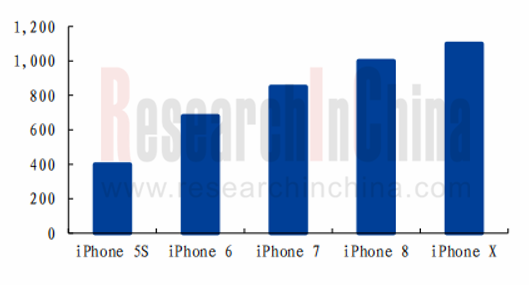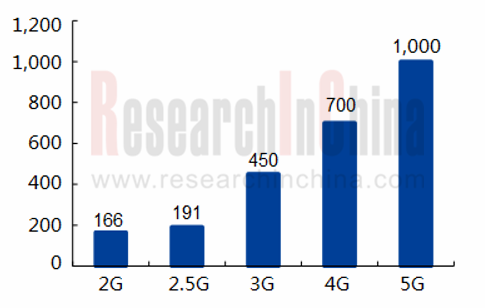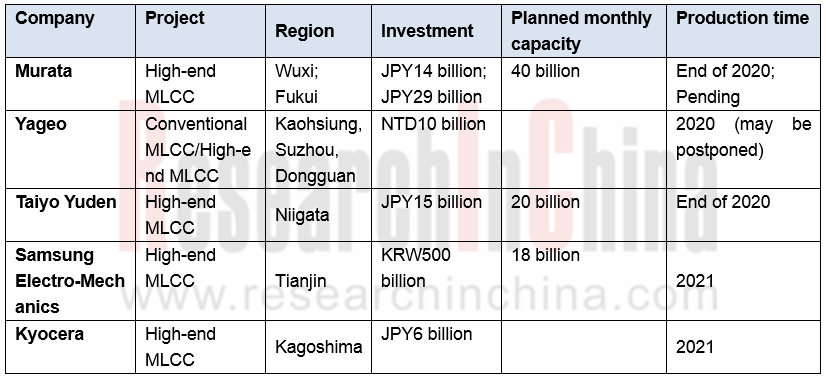As one of the most widely used passive components, MLCC commands approximately 40% of the capacitor market. MLCC finds broad application in fields like communication, consumer electronics, automobile and military, where the robust demand conduces to the expanding MLCC market.
A staggering 64% or so of MLCCs are consumed by consumer electronics, especially smartphones which occupy 39% of total consumption. In iPhone’s case, smartphones with higher configuration use more MLCCs, e.g., an iPhone X needs as many as 1,100 MLCCs compared with an iPhone 5S using 400 pieces. Besides, the portable and intelligent wearables such as TWS headphones and smart watches have drawn much attention from the market over recent years, producing significant demand for MLCCs.

As commercial use of 5G is at a gallop, 5G-enabled smartphones will pack more MLCCs than 4G ones. Examples include a Sub-6Ghz 5G smartphone that uses 10%-15% more MLCCs and an mmWave 5G phone adding 20%-30%. Meanwhile, 5G smartphones’ higher power consumption further drives up demand for high-end, micro/ultra-micro (0201, 01005, etc.) MLCCs with large capacity and low power consumption.

During the faster construction of 5G in 2020, a larger number of 5G base stations to be built and more MLCCs per such a station compared with 4G ones are two factors behind the rising demand for MLCCs. By 2023, global communication base stations’ demand for MLCCs will be 2.1-fold of that in 2019, estimated by Taiyo Yuden. In the meantime, internet of things (IoT) that requires far more stable connectivity will be a beneficiary of low-latency 5G network. A study of VENKEL shows that a terminal needs over 75 MLCCs on average, from which it can be foreseen that more and more connected IOT devices will, beyond doubt, spur the MLCC market to grow.
The development of new energy vehicle and ADAS drives MLCC into a new blue ocean. A common car needs around 3,000 or 4,000 MLCCs while a hybrid/plug-in hybrid vehicle bears around 12,000 pieces and a battery electric vehicle carries virtually 18,000 pieces.
Among vehicle electronic systems, ADAS which applies more MLCCs could collect, detect, recognize and track changed data inside and outside of the vehicle in the shortest time via sensors on the vehicle and helps the driver beware of potential dangers to operate correctly and safely by combining navigation map data to calculate and analyze. Wider coverage of 5G network will be another solution to latency problem. As more and more vehicles carry ADAS that tends to be more intelligent, the demand for MLCCs will multiply.
New energy vehicle with a larger number of control modules like ECU need more passive components to support electronic systems, with a new energy vehicle in want of at least 10,000 MLCCs. With the roll-out of timetables for elimination of ICE vehicles across the world in recent years, new energy vehicles have boasted higher penetration, coupled with more use of MLCCs by a single vehicle, together stimulating the demand for automotive MLCCs.
Of a wide range of automotive MLCC models, those with size ranging from 0402 to 2220 are in use while 0603, 0805 and 1206 get most utilized. Despite unconcern about size of MLCCs, automotive market has a high demanding on them in safety parameters (reliability, service life and failure rate) as well as working temperature, humidity, climate and vibration resistance. Automotive market poses a high entry barrier to MLCC which must be subject to a set of automotive standards (AEC-Q200) and pass quality certification.
It is in the MLCC market that leading players include Murata, Samsung Electro-Mechanics, Yageo, Walsin Technology, Taiyo Yuden, TDK, Kyocera and Chinese Mainland companies like Fenghua Advanced Technology and Chaozhou Three-circle. Since 2016, few MLCC vendors like Murata and TDK have shifted to focus on automotive MLCC, a promising and lucrative high-tech market. This move disrupts the global passive components supply chain and makes low- and mid-end customers turn to companies like Yageo, Fenghua Advanced Technology and Chaozhou Three-circle.
Some vendors have pivoted to the automotive MLCC market.

Murata is the MLCC vendor with the highest market share in the world (approximately 56% of the automotive MLCC market), boasting annual capacity up to 1,100 billion MLCCs or so. In recent years, the company has slashed the capacity of low-end MLCCs while ramping up production of automotive and other high-end products. Murata quickens the R&D and mass production of MLCCs for high-end consumer electronics whilst expediting to launch automotive products. In 2019, Murata began to spawn 008004, which will be used in 5G flagship phones of Apple and Huawei. In April 2020, Murata started mass-production of two new multilayer ceramic capacitors for automotive use -- the NFM15HC105D0G3, which is the world's smallest 0402 size (1.0×0.5mm) three-terminal low-ESL multilayer ceramic capacitor, and the NFM18HC106D0G3, which is the three-terminal low-ESL multilayer ceramic capacitor with the world's highest capacitance of 10μF in 0603 size (1.6×0.8mm), suitable for ADAS and autonomous driving.
The second-ranked Samsung Electro-Mechanics by MLCC market share in the world (ranking fourth in the automotive MLCC market with about 6% share) has followed suit over the recent years, like squeezing out low-end capacity and stepping up the deployment of high-end products. In July 2020, the company developed five new types of MLCCs, including three types for power systems and two types for anti-lock braking systems, which will be available to global automakers in future. Besides building a dedicated automotive production line at the Busan plant, Samsung Electro-Mechanics is pressing ahead with construction of a new plant in Tianjin, China.
Given its inferiority in MLCCs for consumer electronics, TDK cancelled orders for 700 million MLCCs covering about 360 models, and committed itself to mid-to-high-end products in 2017 as the first one aggressively exploring the automotive MLCC market, where TDK now seizes about 25% shares.
MLCC vendors in Mainland China have been developing by leaps and bounds in recent years, especially Fenghua Advanced Technology is one of few Chinese MLCC vendors offering a full range of MLCCs covering 01005-2220 and above sizes with advantages in production scale and technical processes; but it still targets consumer electronics. In 2018, the company launched products in line with the AEC-Q200 standard, but still posing no threat to Japanese and Korean peers due to its weak foundation.
Since 2018, traditional automakers worldwide have begun to deploy electric vehicle manufacturing on a large scale, and the governments have introduced timetables for elimination of ICE vehicle. As the number of MLCCs used in an electric vehicle is 6 times that in an ordinary car, MLCCs are bound to be much sought after. Hundreds of carmakers require automotive MLCCs which are only offered by a few automotive MLCC vendors, inevitably leading to the tight supply of automotive MLCCs in the next two years or three, and a big challenge to any automaker who is in readiness for capacity expansion of electric vehicles and even a mission impossible for emerging automakers because leading MLCC suppliers will give priority to key automakers. The MLCCs from tier-II suppliers as a last resort may cause quality issues and enormous maintenance costs.
Global and China Multi-layer Ceramic Capacitor (MLCC) Industry Report, 2020-2026 highlights the following:
 MLCC industry (definition, classification, industry chain, technology trend, etc.);
MLCC industry (definition, classification, industry chain, technology trend, etc.);
 Global and Chinese MLCC markets (size and forecast, competitive landscape, market segments, etc.);
Global and Chinese MLCC markets (size and forecast, competitive landscape, market segments, etc.);
 Automotive MLCC market (size and forecast, competition pattern, etc.);
Automotive MLCC market (size and forecast, competition pattern, etc.);
 Leading automotive MLCC vendors in China and beyond (profile, operation, business, new products, etc.);
Leading automotive MLCC vendors in China and beyond (profile, operation, business, new products, etc.);
 Upstream MLCC formula vendors (profile, operation, business, new products, etc.)
Upstream MLCC formula vendors (profile, operation, business, new products, etc.)
Automotive Vision Industry Report, 2025
Automotive Vision Research: Average Camera Installation per Vehicle Reaches 5.2 Units, and Front-View Tricam Installation Exceeds 1.2 Million Sets.
From January to September 2025, the total installa...
Automotive Infrared Night Vision System Research Report, 2025
Automotive night vision research: The rise of infrared AEB, with automotive infrared night vision experiencing a 384.7% year-on-year increase from January to September.
From January to September 2025...
New Energy Vehicle Cross-Domain (Electric Drive System and Powertrain Domain) Integration Trend Report 2025-2026
Electric Drive and Powertrain Domain Research: New technologies such as three-motor four-wheel drive, drive-brake integration, and corner modules are being rapidly installed in vehicles.
Electric dri...
Analysis on Desay SV and Joyson Electronic's Electrification, Connectivity, Intelligence and Sharing, 2025
Research on Desay SV and Joyson Electronic: Who is the No.1 Intelligent Supplier?
Both Desay SV and Joyson Electronic are leading domestic suppliers in automotive intelligence. "Analysis on Desay SV ...
OEMs and Tier 1 Suppliers' Cost Reduction and Efficiency Enhancement Strategy Analysis Report, 2025
ResearchInChina released the "OEMs and Tier 1 Suppliers' Cost Reduction and Efficiency Enhancement Strategy Analysis Report, 2025", summarizing hundreds of cost reduction strategies to provide referen...
Automotive Fixed Panoramic Sunroof and Smart Roof Research Report, 2025
With the intelligent application of car roofs as the core, this report systematically sorts out a series of new products such as fixed panoramic sunroof/openable sunroof, ceiling screen, roof ambient ...
Automotive-Grade Power Semiconductor and Module (SiC, GaN) Industry Research Report, 2025
SiC/GaN Research: Sales volume of 800V+ architecture-based vehicles will increase more than 10 times, and hybrid carbon (SiC+IGBT) power modules are rapidly being deployed in vehicles.
Sales volume o...
Cockpit Agent Engineering Research Report, 2025
Cockpit Agent Engineering Research: Breakthrough from Digital AI to Physical AI
Cockpit Agent Engineering Research Report, 2025 starts with the status quo of cockpit agents, summarizes the technical ...
Prospective Study on L3 Intelligent Driving Technology of OEMs and Tier 1 Suppliers, 2025
L3 Research: The Window of Opportunity Has Arrived - Eight Trends in L3 Layout of OEMs and Tier 1 Suppliers
Through in-depth research on 15 OEMs (including 8 Chinese and 7 foreign OEMs) and 9 Tier 1 ...
China Commercial Vehicle IoV and Intelligent Cockpit Industry Research Report 2025
Commercial Vehicle IoV and Cockpit Research: The Third Wave of Passenger Car/Commercial Vehicle Technology Integration Arrives, and T-Box Integrates e-Call and 15.6-inch for Vehicles
I. The third wav...
Intelligent Vehicle Electronic and Electrical Architecture (EEA) and Technology Supply Chain Construction Strategy Research Report, 2025
E/E Architecture Research: 24 OEMs Deploy Innovative Products from Platform Architectures to Technical Selling Points
According to statistics from ResearchInChina, 802,000 passenger cars with domain...
Research Report on Intelligent Vehicle Cross-Domain Integration Strategies and Innovative Function Scenarios, 2025
Cross-Domain Integration Strategy Research: Automakers' Competition Extends to Cross-Domain Innovative Function Scenarios such as Cockpit-Driving, Powertrain, and Chassis
Cross-domain integration of ...
China Autonomous Driving Data Closed Loop Research Report, 2025
Data Closed-Loop Research: Synthetic Data Accounts for Over 50%, Full-process Automated Toolchain Gradually Implemented
Key Points:From 2023 to 2025, the proportion of synthetic data increased from 2...
Automotive Glass and Smart Glass Research Report, 2025
Automotive Glass Report: Dimmable Glass Offers Active Mode, Penetration Rate Expected to Reach 10% by 2030
ResearchInChina releases the Automotive Glass and Smart Glass Research Report, 2025. This r...
Passenger Car Brake-by-Wire (BBW) Research Report, 2025
Brake-by-Wire: EHB to Be Installed in 12 Million Vehicles in 2025
1. EHB Have Been Installed in over 10 Million Vehicles, A Figure to Hit 12 Million in 2025.
In 2024, the brake-by-wire, Electro-Hydr...
Autonomous Driving Domain Controller and Central Computing Unit (CCU) Industry Report, 2025
Research on Autonomous Driving Domain Controllers: Monthly Penetration Rate Exceeded 30% for the First Time, and 700T+ Ultrahigh-compute Domain Controller Products Are Rapidly Installed in Vehicles
L...
China Automotive Lighting and Ambient Lighting System Research Report, 2025
Automotive Lighting System Research: In 2025H1, Autonomous Driving System (ADS) Marker Lamps Saw an 11-Fold Year-on-Year Growth and the Installation Rate of Automotive LED Lighting Approached 90...
Ecological Domain and Automotive Hardware Expansion Research Report, 2025
ResearchInChina has released the Ecological Domain and Automotive Hardware Expansion Research Report, 2025, which delves into the application of various automotive extended hardware, supplier ecologic...